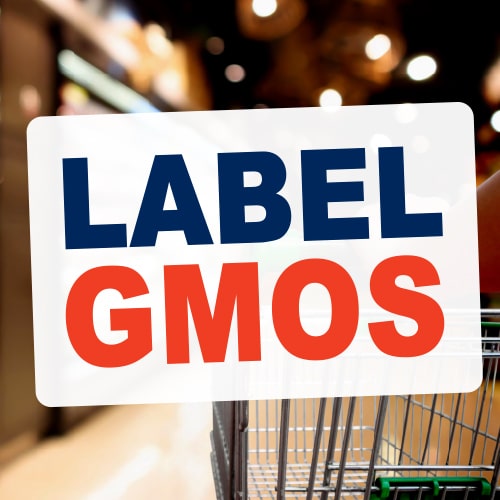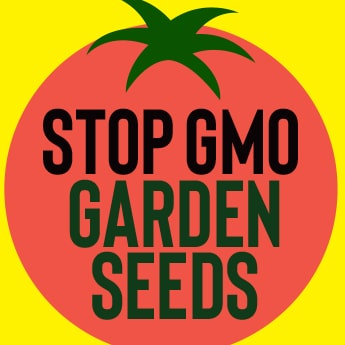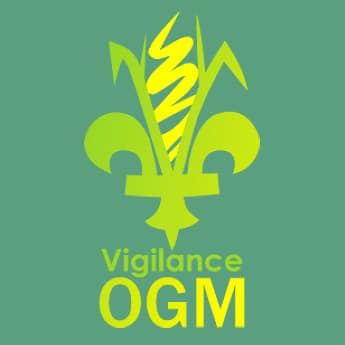Désolé, la version française de cette page ne peut être offerte pour le moment.
“Enviropig™” Background
May 18, 2010
Produced by the Canadian Biotechnology Action Network (CBAN) and Beyond Factory Farming (BFF)
- What is « Enviropig™ »?
- Is « Enviropig™ » An Environmental Solution?
- Who « Created » and Owns « Enviropig™ »?
- Is « Enviropig™ » Safe?
- When will « Enviropig™ » be on the market?
- Do Farmers Need « Enviropig™ »?
What is “Enviropig™”?
Enviropig™ is the trademarked industry name[i] for a pig that has been genetically engineered to excrete less phosphorous in its feces. Enviropig™ was developed by researchers at the University of Guelph in Ontario and could soon be the first genetically modified (GM) (also called genetically engineered or GE) food animal on the market.[ii]
The goal of the GM Enviropig™ is to provide intensive livestock operations (factory farms) with a product to reduce the amount of polluting phosphorous they produce. Phosphorous from animal manure is a nutrient for plants that becomes a pollutant if there is too much of it for crops to absorb, and the excess runs off into streams and lakes. Researchers claim that the feces from Enviropig™ could contain 30 to 70.7% less phosphorus.[iii]
Enviropig™ is genetically engineered to produce the enzyme phytase in its salivary glands to enable more effective digestion of phytate, the from of phosphorus found in pig feed ingredients like corn and soybeans. Scientists inserted a transgene sequence that includes an E-coli bacteria phytase gene and a mouse promoter gene sequence.
Is “Enviropig™” An Environmental Solution?
Excess phosphorous is a product of industrial hog production and managing this pollution is a cost of production for intensive livestock operations in jursidications where phosphorus is regulated. When pig manure spread on farmland exceeds what crops can use while growing, the excess phosphorus runs off as fields drain into surface waters, where it promotes excessive algae growth. The algae forms thick mats, blocking sunlight from reaching deeper waters, and when the algae dies and decomposes it uses up dissolved oxygen in the water. Deprived of oxygen, fish and other organisms die. In addition, often it is blue-green algae that grows in phosphorus-rich waters, producing cyanotoxins which can kill livestock and pets if they drink the polluted water.
Phosphorus pollution is a problem specific to the industrial model of hog production where tens of thousands of pigs under one roof produce too much manure for the surrounding land to use productively. Such intensive, concentrated production means that operations import tonnes of pig feed from distant sources and must then pay the cost of disposing of millions of gallons of liquified hog manure. Operations prefer to spread manure on land within a mile or two of the industrial pig barns because it is expensive to transport heavy liquid manure to more distant fields.
Enviropig™ is designed to reduce the amount of phosphorous coming from the pigs themselves, so that factory farms do not have to pay for other measures such as reducing the number of pigs they raise in one place, changing feed ingredients, trucking liquid manure longer distances, dry composting manure, or expanding the area of land for spreading manure.
There are solutions, however, to the environmental and economic problem of excess phosphorous that do not involve genetically engineering animals:
1. Disperse hog production and reduce the size of operations.
In smaller hog production units that are dispersed over a wide geographic area, phosphorus in pig manure does not become an environmental problem, but is used instead as a valuable fertilizer. Phosphorus is an important plant nutrient and an essential element of soil fertility in farming. Animal manure is an important source of phosphorus for growing field crops, including those used for pig feed.
But Canada’s hog industry has undergone a fundamental change in the past 20 years. Previously, hog production was largely family-farm based and of a very modest scale, with tens of thousands of farmers earning a livelihood raising pigs. Now, the hog industry is dominated by a few giant hog production corporations, some raising the pigs themselves and others contracting farmers to raise pigs for them. The pigs are raised in giant barns that house thousands of pigs together and store liquid manure in pits or tanks close by. Smaller independent farmers have been forced out of business through loss of market access and unfair competition from vertically integrated companies that own hog barns as well as packing plants and other related businesses. Hog production has doubled during this time but there are many fewer farms, each raising many times more hogs.
This dramatic structural change was intended to make Canada a major supplier of hogs on the world market, instead of just providing pork and pork products for Canadians. However, in reality, Canada cannot compete with other countries that have lower labour and feed costs. Trade agreements also mean that cheap pork from other countries can enter our domestic market. The result is that Canada’s hog producers have been forced to sell below their cost of production for many years. Small producers and smaller companies have retired, sold out, or gone bankrupt. Only the biggest producers and some contract producers are left, surviving almost exclusively on government subsidy programs and bailout packages.
In addition to solving the problem of phosphorous pollution, with so many large-scale industrial hog operations collapsing, a return to smaller, less concentrated hog production – combined with other policies that ensure independent farmers have access to markets, get a fair share of returns, and are not undercut by cheap imports from jurisdictions with weak environmental and labour laws – could also be the solution to the severe income crisis in the hog industry.
2. Change and supplement pig feed
Excessive excretion of phosphorus in pig feces results from feeding the animals grain which they are not able to fully digest. Changing pig feed ingredients, and supplementing it, can provide better feed conversion and cut phosphorus production.
The technological solution of a phytase supplement in pig feed has been available to intensive livestock operations for 10 years and is being used more widely as more jurisdictions regulate phosphorus. Throughout the Enviropig™ research, the scientists have acknowledged that the simple solution of a feed supplement existed. They argued however that Enviropig would be the cheaper option: “Since the Enviropig™ is able to digest cereal grain phosphorus there is no need to supplement the diet with either mineral phosphate or commercially produced phytase…” [iv] The effectiveness of the phytase supplement has increased over the years while the price has decreased dramatically. Research conducted by the Ontario Ministry of Agriculture, Food and Rural Affairs, one of the funders of Enviropig™, concludes that “adding phytase does not appear to add more cost to the diet…Using phytase, replacing protein with synthetic amino acids, and by feeding more closely to the animal’s requirements, nitrogen and phosphorus excretion in pig manure can be reduced by up to 50%.” [v]
Who “Created” and Owns « Enviropig™ »?
University of Guelph:
In 1995 scientists at the University of Guelph began research into the GM pig. A team of three researchers, led by Dr. Cecil W. Forsberg, Professor Emeritus in Molecular and Cellular Biology, created the first phytase pig they called “Wayne” in 1999. The University holds patents on the technology in the United States and China. The University of Guelph is entitled to licensing revenue and is looking for companies, particularly in China, to sign licensing agreements.[vi] The total cost of developing Enviropig™ was in the millions of dollars but the University of Guelph will not disclose the exact amount.[vii]
Ontario Pork:
Ontario Pork, the organization that represents hog producers in the province of Ontario and markets their product, is the only private investor in Enviropig™ and owns the trademark Enviropig™. Ontario Pork has the exclusive license to distribute the pig to swine breeders and producers worldwide. Ontario Pork has funded the GM pig research and development to the tune of at least $1.371 million.[viii] The money that Ontario Pork invested in Enviropig™ came directly from Ontario hog producers who pay a compulsory fee on each hog marketed in Ontario. In addition to funding years of experimentation with Enviropig™, in late 2007 the Board of Ontario Pork agreed to fund “the process for applying to regulatory agencies in both Canada and the US for commercial production”.[ix] Ontario Pork is apparently finalizing a commercialization agreement with the university that will allow it a share of the revenues generated from the technology.[x]
Government of Ontario:
The Ontario government funded the development of Enviropig™ through research agreements with the Ontario Ministry of Agriculture, Food and Rural Affairs (OMAFRA) and through the Rural Economic Development Program. Because the technology falls under an agreement that the University has with OMAFRA, the ministry would apparently receive a portion of any potential net revenue.”[xi]
Government of Canada:
The Government of Canada has funded Enviropig™ through research grants from the Natural Sciences and Engineering Research Council as well as through other agreements with Agriculture and Agri-Food Canada.
Advanced Food Materials Network:
AFMNet, a national network of researchers, industry partners and government agencies that funds a small group of projects, funded a three-year project to analyze “the value and ethical concerns of informed stakeholders on specific applications of animal biotechnology in Canada.”
Is « Enviropig™ » Safe?
Is Enviropig™ Safe to Eat?
Enviropig™, like all GM foods in Canada, will be assessed for human safety by Health Canada and classified as a “novel food”. Health Canada, however, has not yet developed specific guidelines for evaluating the safety of GM animals for human consumption. Instead, Canada will rely on the United Nations Codex guidelines for the safety assessment of GM animals and refer to the U.S. Food and Drug Administration.[xii] Health Canada does not conduct any of its own safety tests of GM foods but relies on data submitted directly from the product developer, in this case the University of Guelph. This data is classified as “Confidential Business Information” and is not accessible to the public or to independent scientists. There is no mandatory labeling of GM food in Canada or the U.S.
Is Enviropig™ a Biosafety Hazard?
There is already a precedent for contamination of the food system with Enviropig™. In 2002, eleven piglets at the University of Guelph that had died at or shortly after birth were accidentally sent to a rendering plant and turned into animal feed instead of being destroyed as biological waste. The GM pigs were not approved for animal feed but contaminated 675 tonnes of poultry feed that was sold to egg farmers, turkey farmers and broiler chicken producers. The Canadian Food Inspection Agency ordered a recall of the feed. The then Vice President of Research at the University of Guelph, told the Globe and Mail that, « Things you don’t expect to happen can happen. »[xiii]
When will « Enviropig™ » be on the market?
Canada has not yet created regulations specific to GM animals, yet Enviropig™ could be approved for the market any day.
Environment Canada Approved Enviropig
In February 2010, Environment Canada granted approval to the University of Guelph for the reproduction and exportation of Enviropig™ via a “Significant New Activity Notice”. This notice allows for the reproduction of the GM pigs in controlled facilities, segregated from other animals under specified conditions.
This is the first time that Environment Canada has been directly involved in the approval of a GMO. Environment Canada was given the responsibility for assessing the environmental risks of Enviropig™ because there are no regulations for GM animals in Canada. In cases where regulations do not exist, new products are assessed under the Canadian Environmental Protection Act. (All GM crops in Canada have been approved by the Canadian Food Inspection Agency, an agency under Agriculture and Agri-Food Canada, under the “Plants with Novel Trait” guidelines.)
Health Canada Assessing Food Safety
The University of Guelph is now waiting for Health Canada to approve Enviropig™ for human consumption. According to the University, they submitted an application for approval on April 23, 2009. The application and the process for its evaluation are kept secret by the University and Health Canada so there is no way of knowing when the application could be approved, but it could be granted at any time.
The University also submitted an application for approval to the Canadian Food Inspection Agency (CFIA) which is likely a request to approve Enviropig™ for use in other livestock feed. This is because pigs are rendered to feed to poultry and other animals, as a protein source. The nature of the request to the CFIA is unknown because the agency will neither confirm nor deny that they are assessing a request.[xiv]
Approval requested in the U.S.
In 2007, the University of Guelph submitted a request for approval of Enviropig™ to the U.S. Food and Drug Administration where it will be assessed as a new drug.
Approval requested in China
The University of Guelph is seeking licensees for Enviropig™, especially in China. In 2008, David Hobson of the University of Guelph, and the Board Chair of Ontario Pork traveled to China to “pursue access to China’s regulatory process and potential partners for commercialization of the Enviropig.”[xv]
Do Farmers Need « Enviropig »?
Hog farming in Canada is in deep economic crisis. Farmers have been losing money on every hog that they sell for several years, surviving primarily on off-farm jobs and government subsidies. Management of phosphorus over-production is yet another cost of production, however the GM pig will also come at a cost. Companies could charge fees per hog, similar to Monsanto’s Technology Use Fees charged, per acre, for use of its patented GM seeds. By contrast, the phytase feed supplement is now available at a low price and is being adopted by intensive livestock operations as a quick technological fix to solve the problem of meeting phosphorous pollution regulations.[xvi]
Rather than helping hog producers cope with their economic problems, Enviropig™ threatens to add more costs and severly undermine domestic and export consumer confidence in Canadian pork products. Canada’s hog producers rely on export sales more than any other country. Canada is the world’s third largest pork exporter and represents 20% of world pork trade.[xvii] In 2009, Canadian pork was exported to over 110 countries. These export markets can be unstable and, in the past, Canadian hog export markets, including China, have closed due to concerns about disease (swine flu) and feed additives (Paylean). It is highly likely that export markets will be closed to GM pigs, reducing Canadian sales and depressing prices.
What can we do to stop « Enviropig™ »?
- Write to the Minister of Health today from www.cban.ca/enviropigaction
- Join the Campaign!
- Donate today to support the Campaign, your support is urgently needed.
- Check here for more action options.
For more information on the campaign, the issue and action options: www.cban.ca/enviropig
Contact: Lucy Sharratt, Coordinator, Canadian Biotechnology Action Network, Collaborative Campaigning for Food Sovereignty and Environmental Justice
431 Gilmour Street, Second Floor, Ottawa, Ontario, Canada, K2P 0R5
Phone: 613 241 2267 ext.6 Fax: 613 241 2506 coordinator@cban.ca www.cban.ca
Other Resources:
Beyond Factory Farming www.beyondfactoryfarming.org
Canadian Biotechnology Action Network www.cban.ca/enviropig
Center for Food Safety www.truefoodnow.org
Food and Water Watch www.foodandwaterwatch.org
National Farmers Union www.nfu.ca
University of Guelph www.uoguelph.ca/enviropig
[i] Ontario Pork, the association representing hog producers in the province of Ontario, is the only private investor and owns the trademark “Enviropig™”.
[ii] No genetically modified animals have been approved for eating anywhere in the world. The only GM animal approved globally is the GloFish pet (not approved in Canada). In addition to Enviropig™, the Canadian company Aquabounty is seeking approval for its GM fish, a fast growing Atlantic salmon. They have requested approval in the US but not yet in Canada. For more informtion see www.cban.ca/Resources/Topics/GE-Fish
[iii] The possible percentage changes due to the variables including age and diet. www.uoguelph.ca/enviropig/environmental_benefits.shtml
[iv] www.uoguelph.ca/enviropig
[v] Nutritional Strategies to Decrease Nutrients in Swine Manure, Fact-sheet 04-035, Greg Simpson and Kees de Lange, Ontario Ministry of Agriculture, Food & Rural Affairs, May 2004 reviewed July 2009.
[vi] “Enviropig clears another hurdle”, Better Farming, Feb 24, 2010
[vii] “Enviropig clears another hurdle”, Better Farming, Feb 24, 2010
[viii] “Enviropig clears another hurdle”, Better Farming, Feb 24, 2010
[ix] Highlights from the November 14-15th, 2007 Ontario Pork board meeting. Budget Board Highlights Volume 9, Issue 8. www.ontariopork.on.ca/cms/en/bhnov07.aspx In 2007, the Board of Ontario Pork committed to a reduction in their overall budget of $300K and cut their AGM to one day. At the same meeting however, Ontario Pork approved a funding request University of Guelph researcher Cecil Forsberg to support a two-year process for applying to regulatory agencies in both Canada and the US for commercial production.
[x] Highlights from the November 14-15th, 2007 Ontario Pork board meeting. Budget, Board Highlights Volume 9, Issue 8. http://www.ontariopork.on.ca/cms/en/bhnov07.aspx
[xi] “Enviropig clears another hurdle”, Better Farming, Feb 24, 2010
[xii] Correspondence. To Cathy Holtslander, Beyond Factory Farming, from George Enei, Acting Director General, Science and Risk Assessment Directorate, Environment Canada, April 4, 2009.
[xiii] “Accident Raises GMO-Research Flag: Modified Piglets Turned Into Chicken Feed” Stephen Struass, Globe and Mail, February 19, 2002
[xiv] The Canadian Food Inspection Agency and Health Canada manage the “Biotechnology Notices of Submission Project” which is a voluntary initiative whereby companies can choose to publicize the fact that they have requested regulatory approval for a GM product. The project was launched in 2004 and is intended to increase transparency of GM regulation in Canada however Enviropig™ has never been listed as a GMO pending approval. http://www.inspection.gc.ca/english/plaveg/bio/subs/subliste.shtml
[xv] Highlights October 28th-29th, 2008 Ontario Pork board meeting. http://www.ontariopork.on.ca/cms/en/bhoct08.aspx
[xvi] Adoption rates for Quebec are at 70% and 20-30% in Ontario. The phytase is described as “cost-neutral” because its cost can is offset by the savings associated with reducing phosphorus supplement in feed. Nutritional Strategies to Decrease Nutrients in Swine Manure, Fact-sheet 04-035, Greg Simpson and Kees de Lange, Ontario Ministry of Agriculture, Food & Rural Affairs, May 2004 reviewed July 2009.
[xvii] Canada Pork Industry Thanks Federal Government, Ontario Pork, March 30. 2010.





